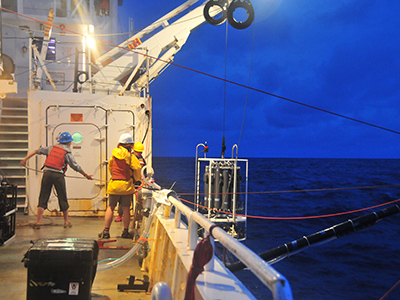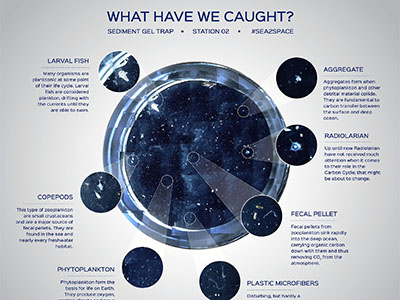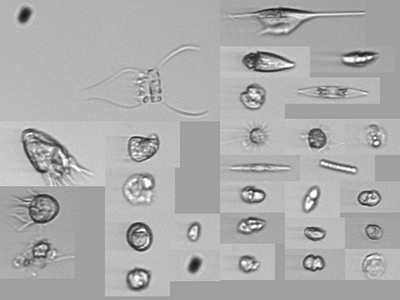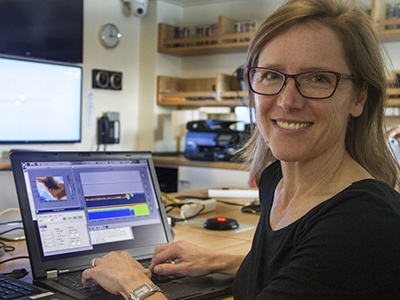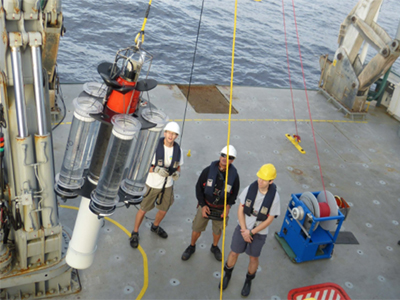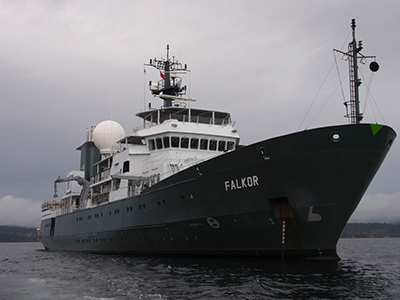Slideshow Gallery
Sea to Space Particle Investigation
View Slideshow » The Sea to Space Particle Investigation aims to improve the accuracy of particle size distribution products gathered from satellite and remote-sensing data. These data contain critical information that can improve our understanding of how Earth's living marine resources and carbon sequestration are responding to rising carbon dioxide levels and climate changes. The field campaign took place from January 24 through February 20, 2017.[Jan-2017]
[Feb-2017]
A satellite image shows the cruise track against a background of ocean color data. Colors indicate the am ... MORE »
[Feb-2017]
Noah Walcutt (URI) inspects mangled sediment traps recovered from the first sampling site. Shark damage w ... MORE »
[Oct-2016]
Working on the ocean presents many challenges, including the threat of rough seas, inclement weather, nos ... MORE »
[Feb-2017]
Nitrogen is a key nutrient at the very base of the food chain, and its availability directly impacts the ... MORE »
[Feb-2017]
[Jan-2017]
Zrinka Ljubesic (University of Zagreb) uses a microscope to identify phytoplankton and zooplankton in sea ... MORE »
[Jun-2020]
The R/V Falkor contains wet and dry laboratory space, a control room for sonar and ROV operations, and of ... MORE »
[Feb-2017]
Dr. Antonio Mannino installs a Coulometer in the on-board wet lab to measure particle productivity in wat ... MORE »
[Feb-2017]
Designed to simulate naturally available light at different times and depth, the electro-squid 4000 exper ... MORE »
[Feb-2017]
Phytoplankton are incubated in a one-of-a-kind photosynthetron, an incubation chamber used to study and m ... MORE »
[Feb-2017]
Water is fed through the FlowCam at a specific magnification wherein a camera is triggered to take a digi ... MORE »
[Feb-2017]
Biological Oceanographer Aimee Neely uses a FlowCam to study particles suspended in seawater. The FlowCam ... MORE »
[Feb-2017]
High-resolution images of suspended particles are captured with an Imaging FlowCytobot (IFCB). The IFCB - ... MORE »
[Feb-2017]
Stephanie Schollaert Uz monitors the speed and direction of water flowing under the ship with an Acoustic ... MORE »
[Feb-2017]
The Wirewalker is a vertical profiling instrument package propelled by ocean waves. When attached to a ca ... MORE »
[Jan-2017]
[Jan-2017]
[Jan-2017]
Melissa Omand, Colleen Durkin, Phillipp Guenther and Ben Knorlein prepare a sediment trap for deployment.
[Jun-2020]
Sediment traps collect particles falling toward the sea floor. These particles - marine snow - are made u ... MORE »
[Feb-2017]
Artist at Sea Kirsten Carlson poses with a replica of a cyanometer, a tool used to measure ’bluenes ... MORE »
[Feb-2017]
Melissa Omand reacts to the first virtual reality experience created on board R/V Falkor: holographic ima ... MORE »
[Feb-2017]
Computer Scientist Benjamin Knorlein (Brown University) integrates virtual reality with a digital hologra ... MORE »
[Feb-2017]
Noah Walcutt examines a holographic camera installed on a rosette. The camera can capture 40,000 images i ... MORE »
[Jun-2020]
A CTD may be incorporated into an array of Niskin bottles (referred to as a rosette). The bottles close a ... MORE »
[Jun-2020]
[May-2018]
The HyperPro radiometer is an in-situ, free-fall profiling unit designed to measure the apparent optical ... MORE »
[May-2018]
A view of the HyperSAS radiometer in the bow during rough seas. The lenses of the radiometer must be clea ... MORE »
[Feb-2017]
[Feb-2017]
Radiometers observe and capture the color of sea and sky by measuring different wavelengths of light. The ... MORE »
[Oct-2016]
[Jan-2017]
[Feb-2017]
The carbon cycle consists of processes that exchange carbon within and between the ocean, atmosphere, Ear ... MORE »
[Jun-2020]
Phytoplankton are critical to our existence. They produce much of the world’s oxygen and remove carbon di ... MORE »
[Jan-2017]
The focus of Chief Scientist Dr. Ivona Cetinic´ (USRA/NASA) and her multidisciplinary team of oceanograph ... MORE »
[Jan-2017]
The R/V Falkor cruise track superimposed on a map of sea surface temperature. The cruise will take 28 day ... MORE »
[Oct-2016]
R/V Falkor was originally built as the Seefalke in 1981 in Lübeck, Germany as a fishery protection vessel ... MORE »
[Oct-2016]
Scientists from NASA Goddard Space Flight Center (GSFC) will collect data in collaboration with the Schmi ... MORE »
[Jan-2017]
The Sea to Space Particle Investigation aims to improve the accuracy of particle size distribution produc ... MORE »





